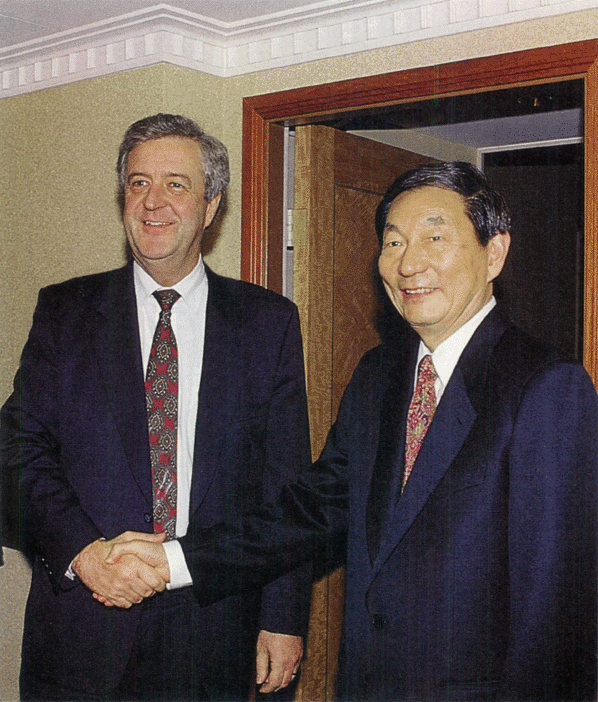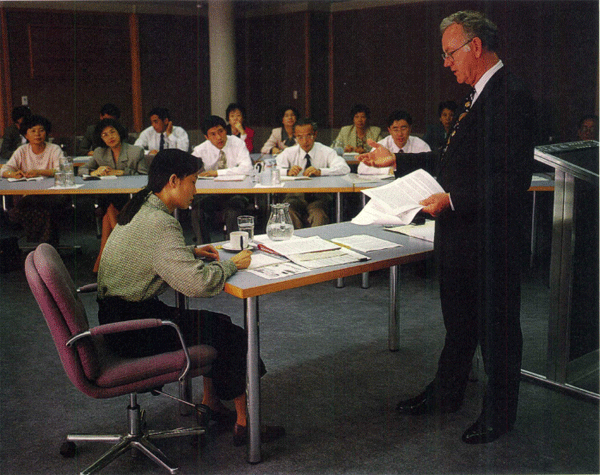Reserve Bank of Australia Annual Report – 1997 The Bank in the Community

Communications
The Bank seeks to enhance the community's understanding of its responsibilities and its monetary and banking policies through a broad communications program. The primary vehicle is the monthly Bulletin. This contains the Semi-Annual Statement on Monetary Policy, a key element in the new monetary policy arrangements, and detailed assessments of economic and financial developments in the intervening quarters. Articles of policy or analytical interest are also included on a regular basis; in 1996/97, these covered bank branch trends in Australia and overseas, managing market risk in banks, measuring wages, recent developments in small business finance, and supervisory aspects of options pricing.
The appearance of senior officers before the House of Representatives Standing Committee on Financial Institutions and Public Administration provides another important opportunity to account publicly for the conduct of Bank policy. The first appearance under the new monetary policy arrangements was in May 1997, the next is scheduled for November 1997.
Speeches and presentations are the other main avenues through which the Bank explains its views to the community. Each year, the Governor and senior officers give a number of major speeches to a wide range of audiences, locally and overseas; in 1996/97, these included the Asialink Group, the Australia-Israel Chamber of Commerce, the Committee for Economic Development of Australia (CEDA), the Conference of Economists, the Economic Society of Australia, the Europe/East Asia Economic Summit, the International Swaps and Derivatives Association, the Securities Institute of Australia and The Sydney Institute. Most major speeches are reproduced in the Bulletin. In addition, less formal addresses are made to different groups of financial market participants and other sectors of the financial community.
In the educational field, the Bank regularly provides speakers for courses run by the Securities Institute of Australia and by Australian universities, and to seminars organised by teachers' associations and related groups in several States. In May 1997, it also held a Seminar for Teachers in Sydney and in Melbourne. These Seminars included presentations on the role/framework of monetary policy, domestic market operations, foreign exchange market operations, prudential supervision of financial institutions, and an overview of current economic conditions. This material is being published for use by other teachers and students at both secondary and tertiary levels.
In July 1996, the Bank hosted the ninth in its series of annual economics conferences, on the theme of ‘The Future of the Financial System’. The Proceedings were published in September 1996. The tenth economics conference, in July 1997, focused on ‘Monetary Policy and Inflation Targeting’; the Proceedings will be published shortly. Economic Group published 10 Research Discussion Papers in 1996/97; this series aims to share with economists outside the Bank the results of current work-in-progress by staff. Bank researchers also made a number of contributions to professional journals, both in Australia and overseas, and gave presentations on their research to conferences organised by academic institutions and other central banks.
In May 1997, the Bank conducted its first conference on matters relevant to bank supervision, the topic chosen being ‘Credit Risk in Banking’. A conference volume will be published shortly.
The Economic and Financial Research Fund (EFRF) is a longstanding arrangement under which the Bank provides support for university projects relevant to the Bank's broad responsibilities. During 1996/97, the EFRF contributed $39,380 to six projects at five Australian universities. The Bank also continued its financial support for the monthly survey of inflationary expectations undertaken by the University of Melbourne's Institute of Applied Economic and Social Research and, in the international sphere, for the Group of 30's study program.
The Bank is developing a web site on the Internet, which will offer a range of information about the Bank's functions and operations as well as the text of important documents published elsewhere by the Bank (including the Semi-Annual Statement on Monetary Policy, speeches and media releases).

Other involvement in the community
The Bank has a range of other contacts with the financial and wider community. It is, for example, the convenor of the Small Business Finance Panel, which meets annually. This Panel, established in 1993, comprises members from a broad spectrum of industries and provides advice to the Bank to improve its understanding of finance issues affecting small businesses.
The Bank has begun planning for a new Australian currency note which will be issued in 2001 to commemorate the centenary of Federation. It will be seeking the views of a panel of community representatives on the themes to be portrayed on this note.
The Bank makes modest donations to a number of charitable institutions Australia-wide; in 1996/97, the amount provided was $22,000. The Governor is also Chairman of the Financial Markets Foundation for Children, the financial community's charity organisation which raises funds for research into medical and social problems affecting children.
As part of its general community relations, the Bank lends some of its artworks to Australian public galleries and similar institutions. During 1996/97, the Bank lent paintings to the Art Galleries of New South Wales and Western Australia, for extended exhibitions which toured nationally, and to the National Library of Australia for an exhibition in Old Parliament House in Canberra. The Bank also makes available for public viewing a small number of artworks and historic photographs from its collection in its Currency Display Centre in Head Office.

Contacts with other central banks
In recent years the Bank has strongly endorsed the pursuit of closer ties among central banks of the Asian region. The vehicle has been an existing group of central banks known as the Executive Meeting of East Asia and Pacific Central Banks (EMEAP). Membership of EMEAP comprises the central banks and monetary authorities of eleven countries: Australia, People's Republic of China, Hong Kong, Indonesia, Japan, Republic of Korea, Malaysia, New Zealand, the Philippines, Singapore and Thailand.
Previously a forum for regular meetings at senior level, the EMEAP arrangements took on a more formal structure in 1996/97. The first meeting of EMEAP Governors was held in Tokyo in July 1996 and the second in Shanghai in July 1997. EMEAP Deputies – at Deputy Governor or equivalent level – also met twice during the year, in Kuala Lumpur in October 1996 and in Hong Kong in March 1997. Three working/study groups have been established covering payments systems and other financial market developments, central bank operations (focusing on reserves management issues and institutional arrangements for closer co-operation), and prudential supervision. The Bank is active in all three groups and has also provided the chairman for the working group on central bank operations. Each group has met several times during the year and produced papers for the meetings of EMEAP Deputies. The groups have also sponsored international seminars on issues related to their particular interests. The Bank participated in an EMEAP reserves management seminar in Singapore in February 1997 and hosted an EMEAP conference on market risk in Sydney in June 1997. In this same month, a joint BIS/EMEAP central bank workshop on interbank clearing and settlement systems was held in Indonesia, jointly hosted by Bank Indonesia and the Bank for International Settlements; two Bank staff gave presentations.
In 1996/97, the Bank signed its sixth bilateral repurchase agreement with EMEAP members, this time with the Bank of Korea. These arrangements (involving agreements to buy and sell back US government securities) are a means for generating additional liquidity in times of need. The other repurchase agreements are with Hong Kong, Indonesia, Japan, Malaysia and Thailand.
In August 1997, the Commonwealth Government agreed to a request by the International Monetary Fund that Australia participate in an international financing package for Thailand. A number of other countries in the Asian region have also agreed to participate. The total package is for about US$15 billion, of which Australia's contribution is up to US$1 billion, in keeping with the contribution of most other countries. The Bank has agreed that the Australian contribution will be in the form of a foreign exchange swap between itself and the Bank of Thailand. Terms and conditions are to be negotiated with the Bank of Thailand, but the swap will be at market-related interest rates and exchange rates.
The Bank's second formal bilateral meeting with the Hong Kong Monetary Authority was held in Sydney in April 1997. These meetings are held on an annual basis, alternating between Australia and Hong Kong.
The Bank also participated in other high-level meetings in the region. These included the SEANZA (South East Asia, New Zealand and Australia) Governors' Symposium in Beijing in November; the annual South Pacific Central Bank Governors' meeting in Wellington in December; two APEC Finance Ministers' meetings in Manila; the SEANZA Forum of Banking Supervisors in Shanghai in June; and the Four Markets Meeting (also involving Hong Kong, Japan and Singapore) in Hong Kong in November. In March, this latter group met in Tokyo in an expanded format styled the Six Markets Meeting, which also included the People's Republic of China and the United States. The group has decided to meet in both formats on an alternating basis.
The Governors have continued their program of regular attendances at the monthly meetings of the Bank for International Settlements (BIS) in Basle. In addition, the Governor has been invited to join Governors from six other BIS member central banks on a BIS steering group on ‘central bank governance’, which will address issues related to the scope of central banking and the costs and efficiency of various central bank functions. Two meetings of this group were held during 1996/97 in conjunction with the regular BIS meetings.
The provision of technical assistance, in various forms, is an important ongoing element of the Bank's relations with other central banks, particularly those in the Asia/Pacific region. In December 1996, the Bank arranged a two-week study tour to Australia for about 30 officers from People's Bank of China, sponsored by the IMF; this group's particular interest was centralising and modernising China's public accounting and its debt and cash management systems. The Bank also received visitors from a number of other central banks for short-term training attachments and provided longer training programs for officers from Bank of Papua New Guinea, Maldives Monetary Authority and Reserve Bank of Zimbabwe.
The Bank provided lecturers for a number of overseas courses and training programs. These included presentations to the South Pacific Central Banks Banking Supervision Workshop (Fiji); an IMF Workshop on Organisation and Human Resource Management (Thailand); the SEANZA Central Banking Course (People's Republic of China); a SEACEN (South East Asian Central Banks) Course on Policies and Open Market Operations of Financial Markets (Taiwan); a SEACEN Seminar on the Role of Central Banks in Payment Systems in the SEACEN Countries (Korea); and an IMF Payments System Workshop for countries of the former Soviet Union (Austria).
Bank officers also visited a number of other central banks to provide technical assistance, including Bank of Papua New Guinea (auditing), State Bank of Vietnam (accounting and auditing), National Reserve Bank of Tonga (bank supervision), Monetary and Foreign Exchange Authority of Macau (review of bank supervisory practices), Bank of Thailand (domestic market and liquidity forecasting operations, as part of an IMF Technical Assistance Mission) and Central Bank of Egypt (review of foreign exchange operations, also in conjunction with the IMF). Three officers are on long-term secondments, two with the IMF in Washington and one with Central Bank of Yemen, under the auspices of the IMF.

Statutory obligations
Equal Employment Opportunity (Commonwealth Authorities) Act
During the year, the Bank developed its fifth plan for activities related to equal employment opportunity. As required under the Equal Employment Opportunity (Commonwealth Authorities) Act 1987, a report for 1995/96 on the Bank's equal employment opportunity program was tabled in Parliament in November 1996.
Freedom of Information Act
Section 8 statement
The Bank is an exempt agency under the Freedom of Information Act 1982 in respect of documents concerning banking operations (including individual open market operations and foreign exchange dealings) and exchange control matters.
Organisation and functions: The Bank is Australia's central bank. It was established by Commonwealth legislation in 1911. Its functions, powers and responsibilities are specified in the Reserve Bank Act 1959, the Banking Act 1959, the Financial Corporations Act 1974 and in Regulations made under those Acts. The Bank's organisation chart appears at the end of this Report.
Categories of documents: Lists of publications, including speeches, articles, occasional papers, information booklets, conference volumes, regular media releases and other publications, are published from time to time in the Bank's monthly Bulletin. Other documents held by the Bank are in the form of working notes and files covering policy and operational matters, statistical data, personnel, premises and general administration.
Facilities for access and Freedom of Information procedures: I nquiries under the Freedom of Information Act, including requests for access to documents, should be directed to the Secretary, Head Office, or the Managers of branches, or the Managing Director at Note Printing Australia. Applications should be accompanied by the application fee (currently $30). Facilities to inspect documents to which access has been granted are available in the Bank's branches.
Section 93 statement
Two requests for access to documents under the Act were received in 1996/97, compared with eight in the previous year. Details for the latest year are set out below:
| Requests received | |
|---|---|
| On hand at 1 July 1996 | 1 |
| Received during year | 2 |
| Action on requests | |
| Access granted in full | – |
| Access granted in part | – |
| Access refused | – |
| Requests withdrawn or lapsed | 3 |
| Current at 30 June 1997 | – |
| Internal review | |
| Applications | 1 |
| Review by Administrative Appeals Tribunal | |
| Outstanding at 1 July 1996 | 1 |
| New applications | – |
| Withdrawn | – |
| Fees and charges collected | |
| Application fees | $100 |
| Charges | Nil |
The result of the above review by the Administrative Appeals Tribunal was handed down in June 1997; it affirmed the Bank's decision not to grant access to certain documents.
The cost to the Bank of administering the Act in 1996/97 is estimated to have been approximately $67,100, compared with approximately $32,800 in the previous year.